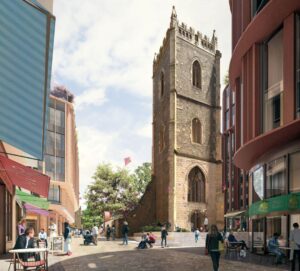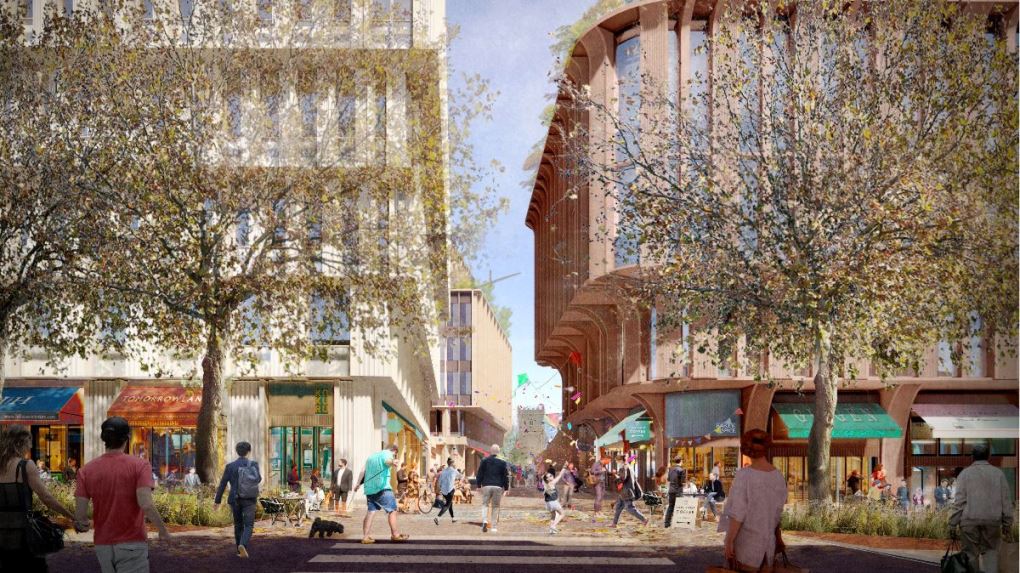On December 20, 2021, St Mary le Port, a key site in the heart of Bristol, England received planning permission for the redevelopment of the area.
The revitalization project will reconnect it to the city center, reinstate street patterns from before World War II, and create a healthy, sustainable, and vibrant piece of city.
Keith Bradley, Senior Partner at the project’s architects, FCBStudios, said “We have worked closely with our client, Bristol City Council, and the local community groups to develop a scheme that reinstates the historic streets, with a focus around the restored ruin of St Mary le Port Church, reconnecting the City to an enhanced Castle Park.”
 Working with their client, MEPC, in partnership with Bristol City Council and the local community, FCBStudios’ design proposes a mixed-use redevelopment that draws on the past, embraces the present, and looks to the future, respecting the historic importance of St Mary le Port tower and ruins, the nearby High Street Vaults, Castle Park, and the wider city center.
Working with their client, MEPC, in partnership with Bristol City Council and the local community, FCBStudios’ design proposes a mixed-use redevelopment that draws on the past, embraces the present, and looks to the future, respecting the historic importance of St Mary le Port tower and ruins, the nearby High Street Vaults, Castle Park, and the wider city center.
“The scheme embraces the future needs of sustainable and healthy, post Covid workspace, above a public face of small scale independent shops and cafes linking through to the historic St Nicholas Market and the wider heart of Bristol City Centre. St Mary le Port is an important part of the current transformation of the Bristol City Centre and we are delighted to receive planning permission,” Bradley added.
There are currently three vacant 1960’s bank buildings on the site on the western edge of Castle Park. In their place, three new buildings of office space and flexible commercial units for independent retailers, cafés, restaurants, and bars are proposed to enhance the central Bristol working and shopping experience.
The architects claim that each design has been carefully considered to respond to their immediate context creating a cohesive and interesting family of new structures for the City, and designed to include the latest sustainable building design thinking with the aim of achieving net carbon zero in operation.
The historic ruins of the church and vaults that sit on site, are to carefully be repaired enabling free access to the public, bringing two historical gems to life whilst creating additional outdoor space that extends into Castle Park.
Roz Bird, Commercial Director at MEPC, said “After two years of detailed consultation with local stakeholders in the community, we are delighted that the Development Control Committee voted this afternoon in favour of our application to rejuvenate the St Mary le Port site.”
“On behalf of MEPC, I would like to say a huge thank you to Bristol for welcoming us with open arms and for working with us to develop plans that will create a new special and unique district for Bristol – that will bring new independent shops catering for all budgets, attract new visitors interested in the ruins of St Mary le Port Church, and deliver a new attractive office location commensurate with Bristol’s ambitions and climate targets,” she added.
“We will now look to continue to engage and work with Bristol City Council, Friends of Castle Park, Bristol Tree Forum, the Civic Society, and the wider community to bring our exciting plans to life,” Bird concluded.
By opening up and improving public access to the Castle Park, reinstating the historic streets and routes which were lost after the war, a vibrant new sustainable place will be established to serve people who work, live, and visit the area, well connected by foot and cycle paths, public buses, and boat.
In addition to setting ambitious and deliverable targets for the three new buildings, the latest thinking in Environmental Net Gain (ENG) will be adopted to help restore the natural environment on site.
An increase of 85% in biodiversity will be provided across the project, with an extensive planting program that will include over 70 new trees in and around the site, improvements to Castle Park itself and biodiverse terraces & green roofs.
Terraced planters help activate the street level while cascading landscaped stepped terraces flow down to the Floating Harbour and rejuvenate the relationship with Castle Park.
Renderings courtesy of FCBStudios.

